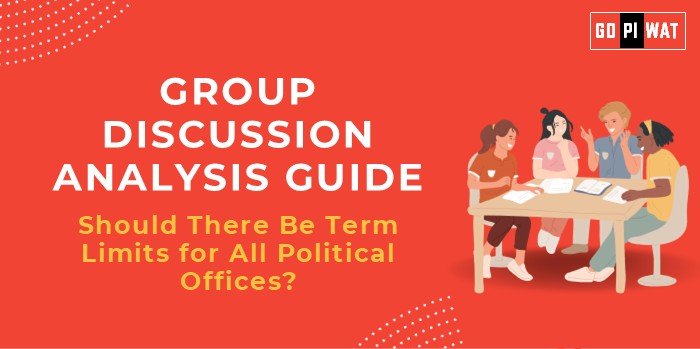📋 Group Discussion (GD) Analysis Guide: Should There Be Term Limits for All Political Offices?
🌐 Introduction
Term limits for political offices remain a contentious issue worldwide, with some arguing they safeguard democracy and accountability, while others contend they hinder experienced leadership. This debate has gained relevance as leaders in countries like China continue to consolidate power, contrasting with strict term limits in nations like the U.S.
📊 Quick Facts & Key Statistics
- 🇺🇸 U.S. Presidential Term Limits: Established in 1951 under the 22nd Amendment, with 100% compliance.
- 🇮🇳 India’s Prime Ministership: No term limits; Jawaharlal Nehru served 17 years, Narendra Modi in his 10th year as of 2024.
- 🇨🇳 China’s Presidency: Abolished term limits in 2018, enabling Xi Jinping’s potential lifelong tenure.
- 📊 Public Opinion: 74% of global citizens favor term limits to prevent power monopolies and foster accountability.
🤝 Stakeholders and Their Roles
- 🏛️ Government Leaders: Create or amend policies regarding term limits.
- 🗳️ Citizens and Voters: Influence decisions through elections and referenda.
- 🎯 Political Parties: Shape policies around leadership and continuity.
- 🌍 International Organizations: Promote democratic practices, including term limits.
📚 Achievements and Challenges
🏆 Achievements
- ✅ Enhanced Accountability: Enforced term limits in the U.S. ensure regular leadership renewal.
- 🔄 Prevention of Power Monopolies: Countries like Brazil have achieved political balance through term restrictions.
- 🌍 Global Examples: Mexico implemented term limits in the 1990s, leading to political diversification.
⚠️ Challenges
- 📉 Leadership Void: Experienced leaders may be prematurely removed.
- 🔄 Policy Disruption: Frequent changes may stall long-term initiatives.
- 📖 Counterexamples: Germany’s Angela Merkel, with no term limits, served 16 years, ensuring economic stability.
💡 Effective Discussion Approaches
📜 Opening Approaches
- ⚖️ “In an era of increasing power centralization, are term limits the ultimate solution for democracy?”
- 🔍 “Can restricting leadership terms prevent authoritarianism without compromising governance?”
🔄 Counter-Argument Handling
- 📊 Discuss the pros and cons of China’s abolishment of term limits and compare with democratic nations enforcing them.
📊 Strategic Analysis of Strengths & Weaknesses
- 🌟 Strengths:
- Prevents authoritarian rule.
- Encourages leadership diversity.
- ⚠️ Weaknesses:
- Potentially disrupts governance continuity.
- Loss of experienced leadership.
- ✨ Opportunities:
- Promotes innovation in governance.
- Strengthens democratic accountability.
- ⚡ Threats:
- Risks destabilizing fragile democracies.
- May encourage populist leadership.
🗣️ Structured Arguments for Discussion
- 👍 Supporting Stance: “Term limits ensure power balance and renew leadership, preventing authoritarian drift.”
- 👎 Opposing Stance: “Flexible tenure without term limits allows for experienced leaders to address long-term challenges.”
- ⚖️ Balanced Perspective: “Term limits should be context-specific, balancing governance continuity with democratic renewal.”
🎓 Connecting with B-School Applications
- 📘 Real-World Applications:
- Succession planning and leadership renewal parallels in business.
- ❓ Sample Interview Questions:
- “How can term limits in politics influence corporate governance?”
- “Discuss the relationship between leadership renewal and long-term organizational strategy.”
- 📖 Insights for B-School Students:
- Explore the effects of leadership longevity on stability.
- Analyze term limits as a governance tool in volatile markets.


